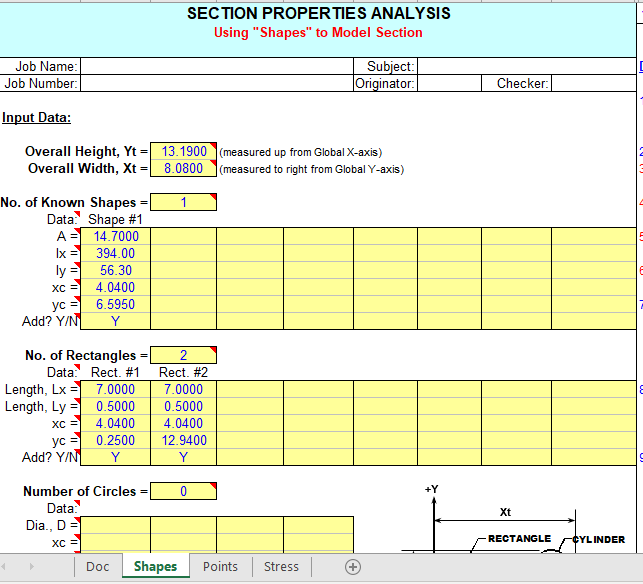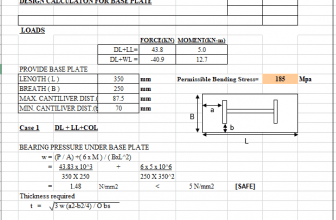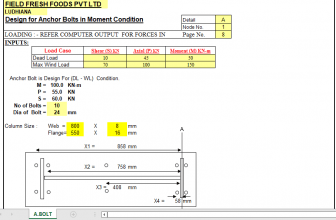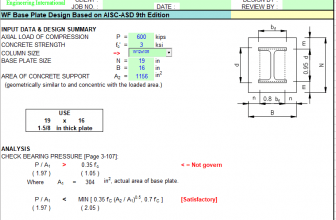
“SECTPROP” — SECTION PROPERTIES ANALYSIS PROGRAM
Program Description:
“SECTPROP” is a spreadsheet program written in MS-Excel for the purpose of calculating section properties.
Two methods of input data are provided, either by adding of deleting “shapes” or by defining a polygon by a
series of “points”. Specifically, the centroid location and total area are determined, as well as the centroidal and
principal axes moments of inertia, radii of gyration, and rotation angle.
This program is a workbook consisting of three (3) worksheets, described as follows:
Worksheet Name Description
Doc This documentation sheet
Shapes Section properties analysis using shapes to model section
Points Section properties analysis using up to 50 points to model section
Stress Stress analysis for symmetric and unsymmetric sections
Program Assumptions and Limitations:
- This program will calculate the centroid location, total cross-sectional area, moments of inertia, and radii of
gyration for the centroidal axes and the principal axes if applicable. The value of the rotation angle between
the centroidal and principal axes is also calculated. - Units are any consistent set of units the user desires.
- In the case of both calculation worksheets, the user should make sure to either clear the contents of all
spreadsheet cells that are not used for input or those cell values should be input = 0. - Using the Shapes worksheet, the origin X-axis MUST BE located at the lowest (bottom) point of the total
section. The overall height of the total section (in Y-direction) MUST BE correctly input as well. - In using the Shapes worksheet, the origin Y-axis MUST BE located at the left most point of the total section.
The overall width of the total section (in X-direction) MUST BE correctly input as well. - Using the Shapes worksheet, there is input for the number of rectangles, circles, cylinders, and symmetrical
shapes with known properties to be either added and/or deleted in order to model a particular section. For
rectangles, circles, and cylinders, there is input for applicable dimensions as well as the location of the
centroid from the assumed origin axes. For shapes with “known” properties, there is input for the self area,
self moments of inertia, and location of the centroid from the assumed origin axes. - Using the Shapes worksheet, any “known” shapes that are input should usually be at least singularly
symmetric (Ixy=0), except for the special case where the entire section to be modeled is at least singularly
symmetric. For example, a “known” angle shape should be modeled as two rectangles, unless there is a
“matching” angle to create overall symmetry about at least one axis. - Using the Shapes worksheet, when a total section is made up of ONLY rectangles, an approximate value of
the torsional constant, ‘J’, is displayed at the bottom of the worksheet (cells A51 and B51) under the
composite section properties calculations. (Note: cells A48, A49, B48, and B49 are “unlocked” so that the
resulting value of ‘J’ may be manually typed in for print out if desired.) - Using the Points worksheet, the modeled section can be any polygon defined by up to 50 connectable points,
each with its own set of X,Y coordinates (3 points are a minimum). The number of points is the actual total
number of different points required to define the polygon. While it is NOT required to redefine the start point to
“define” the polygon (as the program will automatically “close” the polygon after the end point has been
defined), in some cases it may be required to re-enter the coordinates of starting Point #1 directtly after
the last defined point coordinates, so that the plot of the section will appear “closed”. - Using the Points worksheet, coordinates of each point are input, proceeding in a CLOCKWISE direction for
(positive) area to be added, and then in a COUNTER-CLOCKWISE direction for (negative) area to be deleted.
(See “Nomenclature” illustration for example.) - Using the Points worksheet, the origin MUST BE located so that the entire section is in the positive quadrant.
Negative coordinates ARE NOT acceptable. - This program contains numerous “comment boxes” which contain a wide variety of information including
explanations of input or output items, equations used, data tables, etc. (Note: presence of a “comment box”
is denoted by a “red triangle” in the upper right-hand corner of a cell. Merely move the mouse pointer to the
desired cell to view the contents of that particular “comment box”.)





